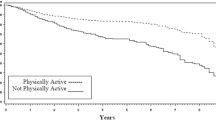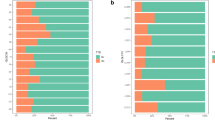Abstract
Purpose
Our study aimed to assess the association between physical function and quality of life (QOL) with physical activity among non-small cell lung cancer (NSCLC) survivors.
Methods
Participants were 92 NSCLC survivors. Physical activity was assessed by a self-report with physiatrist’s interview and the Korean version of the short form of the International Physical Activity Questionnaire (IPAQ-SF). All participants were required to perform three standardized fitness tests. The Korean version of the European Organization for Research and Treatment of Cancer Quality of Life Questionnaire Core 30 (EORTC QLQ-C30) was used to assess QOL. Factors associated with physical functioning and QOL were determined using multiple linear regression.
Results
A significant correlation between metabolic equivalent task minutes per week (MET-min/wk) and aerobic fitness was found (r = 0.277, p = 0.008). Factors associated with aerobic fitness include gender, age, and MET-min/wk. The meeting physical activity guideline group was also a factor associated with aerobic fitness. In the QOL aspect, a significant correlation between MET-min/wk and some QOL score was found. The meeting physical activity guideline group was a factor associated with QOL (global health status, physical function, and role function), not total MET-min/wk.
Conclusions
Increased physical activity was associated with higher aerobic fitness and QOL. Engagement in physical activity that met physical activity guidelines was a factor related to aerobic fitness and better QOL in some domains. To improve aspects of aerobic fitness and QOL, we may consider the pattern of physical activity, including regular participation and intensity, rather than total physical activity including basal activity.
Similar content being viewed by others

References
Jung KW, Won YJ, Kong HJ, Lee ES (2018) Cancer statistics in Korea: incidence, mortality, survival, and prevalence in 2015. Cancer Res Treat 50:303–316
Benzo R, Kelley GA, Recchi L, Hofman A, Sciurba F (2007) Complications of lung resection and exercise capacity: a meta-analysis. Respir Med 101:1790–1797
Edvardsen E, Skjønsberg O, Holme I, Nordsletten L, Borchsenius F, Anderssen S (2015) High-intensity training following lung cancer surgery: a randomised controlled trial. Thorax 70:244–250
Sarna L, Evangelista L, Tashkin D, Padilla G, Holmes C, Brecht ML, Grannis F (2004) Impact of respiratory symptoms and pulmonary function on quality of life of long-term survivors of non-small cell lung cancer. Chest 125:439–445
Arbane G, Tropman D, Jackson D, Garrod R (2011) Evaluation of an early exercise intervention after thoracotomy for non-small cell lung cancer (NSCLC), effects on quality of life, muscle strength and exercise tolerance: randomised controlled trial. Lung Cancer 71:229–234
Handy JR Jr, Asaph JW, Skokan L, Reed CE, Koh S, Brooks G, Douville EC, Tsen AC, Ott GY, Silvestri GA (2002) What happens to patients undergoing lung cancer surgery?: outcomes and quality of life before and after surgery. Chest 122:21–30
Coups EJ, Park BJ, Feinstein MB, Steingart RM, Egleston BL, Wilson DJ, Ostroff JS (2009) Physical activity among lung cancer survivors: changes across the cancer trajectory and associations with quality of life. Cancer Epidemiol Prev Biomarkers 18:664–672
Schmitz KH, Courneya KS, Matthews C, Demark-Wahnefried W, Galvao DA, Pinto BM, Irwin ML, Wolin KY, Segal RJ, Lucia A, Schneider CM, von Gruenigen VE, Schwartz AL (2010) American College of Sports Medicine roundtable on exercise guidelines for cancer survivors. Med Sci Sports Exerc 42:1409–1426
Leach H, Devonish J, Bebb D, Krenz K, Culos-Reed S (2015) Exercise preferences, levels and quality of life in lung cancer survivors. Support Care Cancer 23:3239–3247
Nes LS, Liu H, Patten CA, Rausch SM, Sloan JA, Garces YI, Cheville AL, Yang P, Clark MM (2012) Physical activity level and quality of life in long term lung cancer survivors. Lung Cancer 77:611–616
Sloan JA, Cheville AL, Liu H, Novotny PJ, Wampfler JA, Garces YI, Clark MM, Yang P (2016) Impact of self-reported physical activity and health promotion behaviors on lung cancer survivorship. Health Qual Life Outcomes 14:66
Spruit M, Singh S, Garvey C, ZuWallack R, Nici L, Rochester C, Hill K, Holland A, Lareau S, Man W (2013) ATS/ERS task force on pulmonary rehabilitation. An official American Thoracic Society/European Respiratory Society statement: key concepts and advances in pulmonary rehabilitation. Am J Respir Crit Care Med 188:e13–e64
Rock CL, Doyle C, Demark-Wahnefried W, Meyerhardt J, Courneya KS, Schwartz AL, Bandera EV, Hamilton KK, Grant B, McCullough M (2012) Nutrition and physical activity guidelines for cancer survivors. CA Cancer J Clin 62:242–274
Hechtner M, Eichler M, Wehler B, Buhl R, Sebastian M, Stratmann J, Schmidberger H, Gohrbandt B, Peuser J, Kortsik C (2019) Quality of Life in NSCLC Survivors—A Multicenter Cross-Sectional Study. Journal of Thoracic Oncology 14:420-435
Chun MY (2012) Validity and reliability of Korean version of international physical activity questionnaire short form in the elderly. Korean J Fam Med 33:144–151
Committee IR (2005) Guidelines for data processing and analysis of the International Physical Activity Questionnaire (IPAQ)-short and long forms. https://sites.google.com/site/theipaq/scoring-protocol. Accessed 28 June 2019
Bohannon RW, Wang YC, Gershon RC (2015) Two-minute walk test performance by adults 18 to 85 years: normative values, reliability, and responsiveness. Arch Phys Med Rehabil 96:472–477
Connelly DM, Thomas BK, Cliffe SJ, Perry WM, Smith RE (2009) Clinical utility of the 2-minute walk test for older adults living in long-term care. Physiother Can 61:78–87
Gershon RC, Cella D, Fox NA, Havlik RJ, Hendrie HC, Wagster MV (2010) Assessment of neurological and behavioural function: the NIH toolbox. Lancet Neurol 9:138–139
Roberts HC, Denison HJ, Martin HJ, Patel HP, Syddall H, Cooper C, Sayer AA (2011) A review of the measurement of grip strength in clinical and epidemiological studies: towards a standardised approach. Age Ageing 40:423–429
Singh SJ, Puhan MA, Andrianopoulos V, Hernandes NA, Mitchell KE, Hill CJ, Lee AL, Camillo CA, Troosters T, Spruit MA (2014) An official systematic review of the European Respiratory Society/American Thoracic Society: measurement properties of field walking tests in chronic respiratory disease. In. Eur Respiratory Soc 44:1447–1478
Butland RJ, Pang J, Gross ER, Woodcock AA, Geddes DM (1982) Two-, six-, and 12-minute walking tests in respiratory disease. Br Med J (Clin Res Ed) 284:1607–1608
Uhm KE, Yoo JS, Chung SH, Lee JD, Lee I, Kim JI, Lee SK, Nam SJ, Park YH, Lee JY, JBcr, treatment (2017) Effects of exercise intervention in breast cancer patients: is mobile health (mHealth) with pedometer more effective than conventional program using brochure? Breast Cancer Res Treat 161:443–452
Fayers P, Aaronson N, Bjordal K, Groenvold M, Curran D, Bottomley A (2001) EORTC QLQ-C30 Scoring Manual (ed 3). Brussels, Belgium. In. EORTC publications
Philip EJ, Coups EJ, Feinstein MB, Park BJ, Wilson DJ, Ostroff JS (2014) Physical activity preferences of early-stage lung cancer survivors. Support Care Cancer 22:495–502
Michaels C (2016) The importance of exercise in lung cancer treatment. Transl Lung Cancer Res 5:235
Bade BC, Thomas DD, Scott JB, Silvestri GA (2015) Increasing physical activity and exercise in lung cancer: reviewing safety, benefits, and application. J Thorac Oncol 10:861–871
Crandall K, Maguire R, Campbell A, Kearney N (2014) Exercise intervention for patients surgically treated for Non-Small Cell Lung Cancer (NSCLC): a systematic review. Surg Oncol 23:17–30
Ostroff JS, Krebs P, Coups EJ, Burkhalter JE, Feinstein MB, Steingart RM, Logue AE, Park BJ (2011) Health-related quality of life among early-stage, non-small cell, lung cancer survivors. Lung Cancer 71:103–108
Yang P, Cheville AL, Wampfler JA, Garces YI, Jatoi A, Clark MM, Cassivi SD, Midthun DE, Marks RS, Aubry M-C (2012) Quality of life and symptom burden among long-term lung cancer survivors. Journal of Thoracic Oncology 7:64-70
Funding
This work was supported by the National Cancer Center Grant (NCC-1810303-1).
Author information
Authors and Affiliations
Corresponding author
Ethics declarations
This study was approved by the Institutional Review Board, and written informed consent was obtained from each participant.
Conflict of interest
The authors declare that they have no conflict of interest.
Additional information
Publisher’s note
Springer Nature remains neutral with regard to jurisdictional claims in published maps and institutional affiliations.
Rights and permissions
About this article
Cite this article
Yoo, J.S., Yang, H.C., Lee, J.M. et al. The association of physical function and quality of life on physical activity for non-small cell lung cancer survivors. Support Care Cancer 28, 4847–4856 (2020). https://doi.org/10.1007/s00520-020-05302-6
Received:
Accepted:
Published:
Issue Date:
DOI: https://doi.org/10.1007/s00520-020-05302-6



